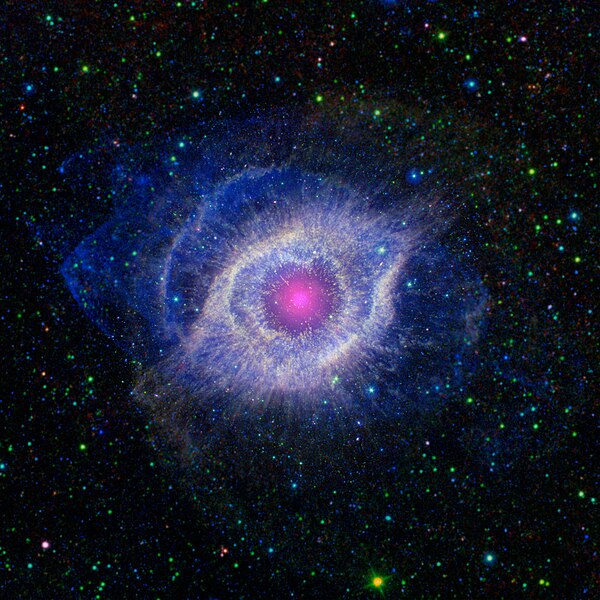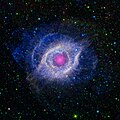Plik:Helix Nebula - Unraveling at the Seams.jpg

Rozmiar pierwotny (6019 × 6019 pikseli, rozmiar pliku: 14,92 MB, typ MIME: image/jpeg)
| Plik Helix Nebula - Unraveling at the Seams.jpg znajduje się w Wikimedia Commons – repozytorium wolnych zasobów. Dane z jego strony opisu znajdują się poniżej. |
Opis
| OpisHelix Nebula - Unraveling at the Seams.jpg |
English: A dying star is throwing a cosmic tantrum in this combined image from NASA's Spitzer Space Telescope and the Galaxy Evolution Explorer (GALEX), which NASA has lent to the California Institute of Technology in Pasadena. In death, the star's dusty outer layers are unraveling into space, glowing from the intense ultraviolet radiation being pumped out by the hot stellar core.
This object, called the Helix nebula, lies 650 light-years away, in the constellation of Aquarius. Also known by the catalog number NGC 7293, it is a typical example of a class of objects called planetary nebulae. Discovered in the 18th century, these cosmic works of art were erroneously named for their resemblance to gas-giant planets. Planetary nebulae are actually the remains of stars that once looked a lot like our sun. These stars spend most of their lives turning hydrogen into helium in massive runaway nuclear fusion reactions in their cores. In fact, this process of fusion provides all the light and heat that we get from our sun. Our sun will blossom into a planetary nebula when it dies in about five billion years. When the hydrogen fuel for the fusion reaction runs out, the star turns to helium for a fuel source, burning it into an even heavier mix of carbon, nitrogen and oxygen. Eventually, the helium will also be exhausted, and the star dies, puffing off its outer gaseous layers and leaving behind the tiny, hot, dense core, called a white dwarf. The white dwarf is about the size of Earth, but has a mass very close to that of the original star; in fact, a teaspoon of a white dwarf would weigh as much as a few elephants! The glow from planetary nebulae is particularly intriguing as it appears surprisingly similar across a broad swath of the spectrum, from ultraviolet to infrared. The Helix remains recognizable at any of these wavelengths, but the combination shown here highlights some subtle differences. The intense ultraviolet radiation from the white dwarf heats up the expelled layers of gas, which shine brightly in the infrared. GALEX has picked out the ultraviolet light pouring out of this system, shown throughout the nebula in blue, while Spitzer has snagged the detailed infrared signature of the dust and gas in yellow A portion of the extended field beyond the nebula, which was not observed by Spitzer, is from NASA's all-sky Wide-field Infrared Survey Explorer (WISE). The white dwarf star itself is a tiny white pinprick right at the center of the nebula. The brighter purple circle in the very center is the combined ultraviolet and infrared glow of a dusty disk circling the white dwarf (the disk itself is too small to be resolved). This dust was most likely kicked up by comets that survived the death of their star. Before the star died, its comets, and possibly planets, would have orbited the star in an orderly fashion. When the star ran out of hydrogen to burn, and blew off its outer layers, the icy bodies and outer planets would have been tossed about and into each other, kicking up an ongoing cosmic dust storm. Any inner planets in the system would have burned up or been swallowed as their dying star expanded. Infrared data from Spitzer for the central nebula is rendered in green (wavelengths of 3.6 to 4.5 microns) and red (8 to 24 microns), with WISE data covering the outer areas in green (3.4 to 4.5 microns) and red (12 to 22 microns). Ultraviolet data from GALEX appears as blue (0.15 to 2.3 microns). |
| Data | (released) |
| Źródło | http://www.nasa.gov/multimedia/imagegallery/image_feature_2368.html; see also https://photojournal.jpl.nasa.gov/catalog/PIA15817 and http://www.spitzer.caltech.edu/images/5259-sig12-011-The-Helix-Nebula-Unraveling-at-the-Seams |
| Autor | NASA/JPL-Caltech |
Ta grafika lub film został skatalagowany przez Jet Propulsion Lab Stanów Zjednoczonych Ameryki National Aeronautics and Space Administration (NASA)pod Photo ID: PIA15817. Ten szablon nie wskazuje stanu prawnego pliku. Standardowy szablon licencji jest nadal wymagany. Aby dowiedzieć się więcej, zajrzyj na stronę Commons:Licencja. Inne języki:
العربية ∙ беларуская (тарашкевіца) ∙ български ∙ català ∙ čeština ∙ dansk ∙ Deutsch ∙ English ∙ español ∙ فارسی ∙ français ∙ galego ∙ magyar ∙ հայերեն ∙ Bahasa Indonesia ∙ italiano ∙ 日本語 ∙ македонски ∙ മലയാളം ∙ Nederlands ∙ polski ∙ português ∙ русский ∙ sicilianu ∙ slovenščina ∙ Türkçe ∙ українська ∙ 简体中文 ∙ 繁體中文 ∙ +/− |
Licencja
| Public domainPublic domainfalsefalse |
| Ten plik jest w domenie publicznej ponieważ został stworzony przez NASA. Polityka praw autorskich NASA stwierdza, że „materiały NASA nie są chronione prawami autorskimi, chyba że zapisano inaczej”. (NASA copyright policy lub JPL Image Use Policy). |  | |
 |
Uwaga:
|
Podpisy
Obiekty przedstawione na tym zdjęciu
przedstawia
2 paź 2012
image/jpeg
Historia pliku
Kliknij na datę/czas, aby zobaczyć, jak plik wyglądał w tym czasie.
| Data i czas | Miniatura | Wymiary | Użytkownik | Opis | |
|---|---|---|---|---|---|
| aktualny | 22:08, 8 paź 2012 |  | 6019 × 6019 (14,92 MB) | Mutante | User created page with UploadWizard |
Lokalne wykorzystanie pliku
Poniższa strona korzysta z tego pliku:
Globalne wykorzystanie pliku
Ten plik jest wykorzystywany także w innych projektach wiki:
- Wykorzystanie na ja.wikipedia.org
- Wykorzystanie na sk.wikipedia.org
Metadane
Niniejszy plik zawiera dodatkowe informacje, prawdopodobnie dodane przez aparat cyfrowy lub skaner użyte do wygenerowania tego pliku.
Jeśli plik był modyfikowany, dane mogą być częściowo niezgodne z parametrami zmodyfikowanego pliku.
| Źródło | Spitzer Space Telescope |
|---|---|
| Warunki wykorzystania | |
| Data i czas utworzenia oryginału | 27 wrz 2012 |
| Szerokość | 6019 px |
| Wysokość | 6019 px |
| Bitów na próbkę |
|
| Metoda kompresji | LZW |
| Interpretacja fotometryczna | RGB |
| Orientacja obrazu | normalna |
| Próbek na piksel | 3 |
| Rozdzielczość w poziomie | 72 punktów na cal |
| Rozdzielczość w pionie | 72 punktów na cal |
| Rozkład danych | format masywny |
| Użyte oprogramowanie | Adobe Photoshop CS3 Windows |
| Data i czas modyfikacji pliku | 10:40, 2 paź 2012 |
| Przestrzeń kolorów | sRGB |
| Szerokość obrazu | 6019 px |
| Wysokość obrazu | 6019 px |
| Ochrona prawem autorskim | Status praw autorskich nieznany |
| Data i czas zeskanowania | 03:40, 2 paź 2012 |
| Data ostatniej modyfikacji metadanych | 03:40, 2 paź 2012 |
| Unikalny identyfikator oryginalnego dokumentu | xmp.did:99CC7C75FA236811822A8DEC83A20A0F |
| Słowa kluczowe |
|
| Kontakt |
http://www.spitzer.caltech.edu 1200 E. California Blvd. Pasadena, CA, 91125 USA |
